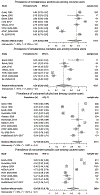The importance of considering polysubstance use: lessons from cocaine research
- PMID: 30195242
- PMCID: PMC7450360
- DOI: 10.1016/j.drugalcdep.2018.07.025
The importance of considering polysubstance use: lessons from cocaine research
Abstract
Background: Polysubstance use (PSU) is prevalent among individuals with substance use disorders, but the vast majority of preclinical substance use research has focused on individual substances in isolation. Cocaine has been prevalent in the repertoire of persons who use more than one illicit substance.
Methods: We conducted a meta-analysis combining results from literature searches and secondary data analyses to estimate the prevalence of simultaneous and concurrent cocaine + alcohol and cocaine + cannabis use among cocaine users. We next summarized the small body of literature on behavioral, cognitive and neurobiological consequences of cocaine PSU across species, with a focus on alcohol and cannabis. Finally, we used systematic literature searches to assess the extent to which human and animal studies on the neurobiological consequences of cocaine include PSU subjects.
Results: The estimated prevalence of simultaneous and concurrent alcohol use among human cocaine users was 74% and 77%, respectively. The estimated prevalence of simultaneous and concurrent cannabis use among cocaine users was 38% and 64%, respectively. Consumption of alcohol or cannabis with cocaine enhances subjective responses to cocaine, concomitant with changes in cocaine metabolism that increase blood cocaine levels, and, in the case of alcohol, produce the psychoactive metabolite cocaethylene. There is also consistent evidence for neurobiological effects of cocaine + alcohol combinations. However, animal PSU research with cocaine lags behind human research.
Conclusion: Based on the prevalence and known consequences of PSU, consideration of PSU in both human and animal research is vital for understanding patterns of substance use.
Keywords: Alcohol; Cannabis; Cocaethylene; Neurocognitive; Neuroimage.
Copyright © 2018 Elsevier B.V. All rights reserved.
Conflict of interest statement
Conflict of interest
No conflict declared
Figures
Similar articles
-
The relation between gray matter volume and the use of alcohol, tobacco, cocaine and cannabis in male polysubstance users.Drug Alcohol Depend. 2018 Jun 1;187:186-194. doi: 10.1016/j.drugalcdep.2018.03.010. Epub 2018 Apr 15. Drug Alcohol Depend. 2018. PMID: 29679913
-
Sequencing hour-level temporal patterns of polysubstance use among persons who use cocaine, alcohol, and cannabis: A back-translational approach.Drug Alcohol Depend. 2024 May 1;258:111272. doi: 10.1016/j.drugalcdep.2024.111272. Epub 2024 Mar 22. Drug Alcohol Depend. 2024. PMID: 38555662 Free PMC article.
-
Driving behavior of alcohol, cannabis, and cocaine abuse treatment clients and population controls.Am J Drug Alcohol Abuse. 2004 May;30(2):429-44. doi: 10.1081/ada-120037386. Am J Drug Alcohol Abuse. 2004. PMID: 15230084
-
[Tobacco use and illicit substance use disorders: what should we have to do?].Presse Med. 2013 May;42(5):795-805. doi: 10.1016/j.lpm.2012.11.015. Epub 2013 Mar 23. Presse Med. 2013. PMID: 23528335 Review. French.
-
[Psychoactive substance use during pregnancy: a review].Encephale. 2010 Feb;36(1):33-8. doi: 10.1016/j.encep.2008.12.009. Epub 2009 Apr 23. Encephale. 2010. PMID: 20159194 Review. French.
Cited by
-
One Is Not Enough: Understanding and Modeling Polysubstance Use.Front Neurosci. 2020 Jun 16;14:569. doi: 10.3389/fnins.2020.00569. eCollection 2020. Front Neurosci. 2020. PMID: 32612502 Free PMC article. Review.
-
Emergency department visits and trends related to cocaine, psychostimulants, and opioids in the United States, 2008-2018.BMC Emerg Med. 2022 Feb 4;22(1):19. doi: 10.1186/s12873-022-00573-0. BMC Emerg Med. 2022. PMID: 35120449 Free PMC article.
-
Cocaethylene, simultaneous alcohol and cocaine use, and liver fibrosis in people living with and without HIV.Drug Alcohol Depend. 2022 Mar 1;232:109273. doi: 10.1016/j.drugalcdep.2022.109273. Epub 2022 Jan 12. Drug Alcohol Depend. 2022. PMID: 35033954 Free PMC article.
-
THC exposure during adolescence does not modify nicotine reinforcing effects and relapse in adult male mice.Psychopharmacology (Berl). 2020 Mar;237(3):801-809. doi: 10.1007/s00213-019-05416-8. Epub 2019 Dec 19. Psychopharmacology (Berl). 2020. PMID: 31858159
-
Adverse drug-related effects among electronic dance music party attendees.Int J Drug Policy. 2019 Nov;73:81-87. doi: 10.1016/j.drugpo.2019.07.005. Epub 2019 Jul 23. Int J Drug Policy. 2019. PMID: 31349134 Free PMC article.
References
-
- Aharonovich E, Liu X, Samet S, Nunes E, Waxman R, Hasin D, 2005. Post discharge cannabis use and its relationship to cocaine, alcohol, and heroin use: a prospective study. Am. J. Psychiatry 162, 1507–1514. - PubMed
-
- Aspen JM, Winger G, 1997. Ethanol effects on self-administration of alfentanil, cocaine, and nomifensine in rhesus monkeys. Psychopharmacology (Berl.) 130, 222–227. - PubMed
Publication types
MeSH terms
Grants and funding
LinkOut - more resources
Full Text Sources
Other Literature Sources
Medical


